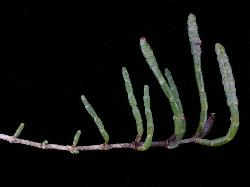- Taxon
- Gallery
- ≡ Sarcocornia quinqueflora (Bunge ex Ung.-Sternb.) A.J.Scott, Bot. J. Linn. Soc. 75: 368 (1978)
- = Salicornia australis Sol. ex G.Forst. nom. inval., nom. nud.
- = Salicornia australis Sol. ex F.Muell (1869)
- = Salicornia australis Sol. ex. Benth. (1870) nom. illeg.
- = Arthrocnemum heptiflorum Moss (1954) nom. illeg., nom. superfl.
A perennial subshrub with prostrate woody stems ± 3–4 mm. diam., up to 3 dm. or more long; branches ∞, the plant forming extensive patches up to 6 dm. or more diam. Branchlets mainly opp., us. crowded, erect or ascending, completely invested by lvs, which are long-persistent in withered state. Lvs opp., ± translucent, succulent, green or flushed with red; the pairs completely fused to form a terete "joint" 5–6–(15) × 3–7 mm.; apex free, forming a "collar" with 2 minute lobes. Fls axillary, in upper portion of branchlets, forming a "spike" with shorter, thicker "joints"; the fls sunk in axils, 5–10–(15) in a ring. Per. fleshy, thickened, ± urceolate, with 3–5 minute teeth; stamens 1–2; style branches 2, stigmatic portion linear, minutely papillose. Fr. ± ovoid; seeds ± 2 mm. diam., with coriac. testa clad in minute hooked hairs.
[From: Allan (1961) Flora of New Zealand. Volume 1 as Salicornia australis Sol. ex. Benth]
| Category | Number |
|---|---|
| Indigenous (Non-endemic) | 1 |
| Total | 1 |




